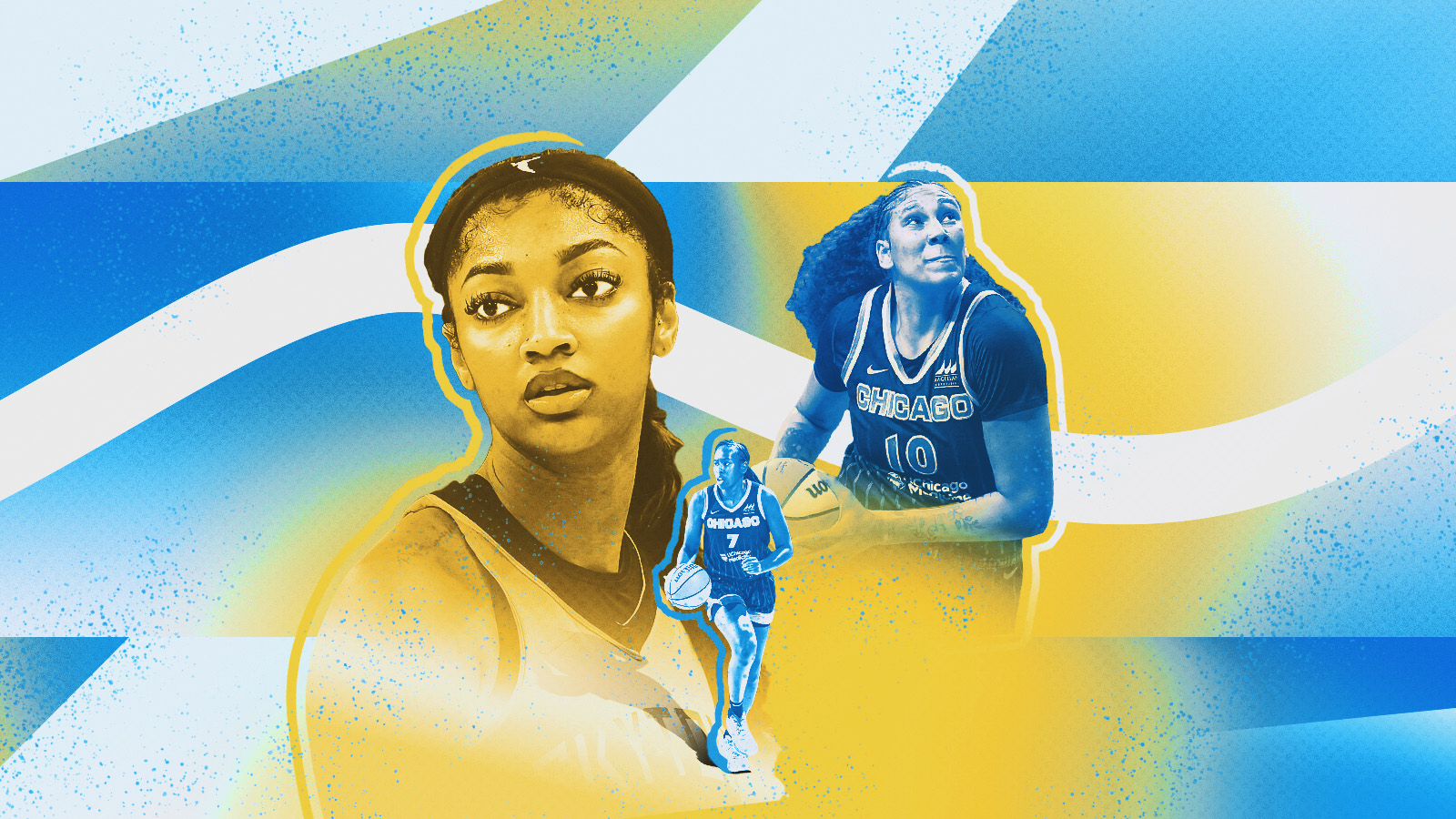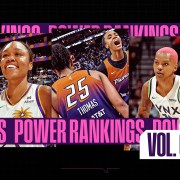After over-performing on modest expectations during the 2024 season, the Chicago Sky entered 2025 as one of the league’s trendiest picks to keep improving. The issue, perhaps, was that many–including key decision makers within the team’s front office–expected a more than reasonable degree of improvement in year two of a new era. As a result, 2025 turned out to be the proverbial “two steps back” that followed the franchise’s positive step forward in 2024.
Season In Review
Recapping a team’s entire year through the lens of just two early-season games is usually a lazy oversimplification—but for the 2025 Sky, it might be perfectly fitting. Chicago’s 35-point season-opening loss to the Indiana Fever on national television (May 17) underscored what many had warned all winter: this team wasn’t yet equipped to trade blows with the WNBA’s elite. Regardless of how you rated the Fever then—or as the season unfolded—it was clear that Chicago’s “rival” a few hours southeast had been far more justified in pushing their chips in last offseason.
Fast forward a few weeks to another high-profile matchup with Indiana, this one dressed up with United Center glitz and a 20,000-seat stage, and it was déjà vu in all the wrong ways. The Sky suffered a narrower but still lopsided 27-point defeat and, far worse, lost key offseason addition Courtney Vandersloot for the year. After just seven games, it might have been premature to pronounce the season dead, but with only two wins (both against the equally struggling Dallas Wings) and the team’s most crucial connector gone, even the most optimistic basketball coroner would have struggled to find a pulse.
What followed mostly confirmed those early fears. A respectable 4–5 stretch in 9 games before the July All-Star break—highlighted by a marquee win over the league-leading Minnesota Lynx—proved to be only a brief reprieve. Chicago limped to the finish line with a joint-league-worst 10–34 record, with only the swap rights from the Marina Mabrey trade with Connecticut able to thank for having a seat at the lottery table next spring.
With that backdrop, let’s dig into the key takeaways from the Sky’s turbulent 2025 campaign, what fans will be watching for in the offseason, and how this oft-in-turmoil franchise will fare in the years ahead.
Biggest Takeaways from 2025
Angel Reese is the real deal.
Reese’s rookie season confirmed what many suspected despite her puzzling slide in the 2024 draft: she was a WNBA-caliber player. Concerns about how her game would translate weren’t baseless, but her college tape always suggested a long-term pro who could contribute quickly and grow into something far greater.
In 2025, she accelerated that growth even faster than many of her biggest supporters expected. Credit starts with Reese herself, whose approach to development—dating back to Maryland—has been shown to consistently produce real improvement. Head coach Tyler Marsh also deserves mention; despite broader criticism of his debut season, he deployed Reese more creatively, especially off the dribble, than the 2024 staff led by Teresa Weatherspoon. And Vandersloot’s season-ending injury, while unfortunate, gave Reese more on-ball reps and playmaking opportunities. Whatever the catalyst, Reese has moved well beyond “promising rookie” status and now projects as a marquee, all-WNBA-level player for the next decade.
Jeff Pagliocca definitely outkicked his coverage.
Aside from Reese’s rise, the defining memory of the 2025 Chicago Sky is the front office’s critical miscalculation. This roster was nowhere near ready to sacrifice future assets for short-term gains, yet GM Jeff Pagliocca bet big anyway. Whether the Ariel Atkins trade came from his own conviction or ownership pressure, it was a clear mistake as soon as it was made—and it only looked worse as the season unraveled.
Pagliocca can’t be blamed for the team’s brutal injury luck, and perhaps a healthy Vandersloot would have improved results, but nothing on the floor suggested this team was a contender. Losing another future first-rounder (on top of the 2025 pick that became Rookie of the Year runner-up Sonia Citron) for Atkins is a blunder Pagliocca shouldn’t get a second chance to correct.
The franchise cannot continue operating with this infrastructure.
This could be taken literally, but the Sky’s need for a practice facility has been an over-discussed (though extremely accurate) talking point over the last couple of seasons, which should be rectified in the very near future with the opening of a new facility in Bedford Park. But the deeper problem lies higher up, where they continue to lag behind the league in organizational consistency and discipline.
Pagliocca’s 2023 hire after James Wade’s departure was backed by little evidence on his résumé that he was ready for a GM role. His first offseason, in fairness, netted Reese and Kamilla Cardoso but with significant departures: franchise cornerstone Kahleah Copper, respected vets Courtney Williams and Alanna Smith, and what’s become a likely top-two pick in 2026. Subsequent moves—trading valuable future assets for Atkins and again for Hailey Van Lith, a risky first-rounder who largely disappointed in 2025—only reinforced the sense of drift.
The revolving door on the sideline tells a similar story. Marsh, for me, is a better coach than Teresa Weatherspoon, but Weatherspoon exceeded expectations in her lone season and should never have been dismissed so quickly. While Pagliocca nominally made that call, it’s easy to wonder whether ownership played a role.
And that’s the crux. Improved facilities will close some gaps, but without a genuine change in how ownership operates—I’m talking more than a PR splash like the Dwyane Wade buy-in—Chicago will remain behind its peers. Until leadership treats the franchise as both a serious basketball project and a professional business, missteps like the late season fallout with Reese will remain the rule, not the exception.
Biggest Questions for 2026
How do you flip this into a winning roster in 2026?
Had Chicago made clear on-court progress, nurtured its relationship with Reese and Cardoso, and kept control of its draft assets, this would be a much simpler question. Instead, assembling a playoff—or even fringe-contending—roster now feels daunting. In an offseason loaded with free agents, Chicago should theoretically be an attractive destination, but it’s hard to picture top players racing to the Windy City in the current climate.
Assume for a moment that Reese returns (we’ll address the alternative later). The glaring needs are on the perimeter, where only Hailey Van Lith is under contract. Chicago would need (1) a ball-dominant table-setter in the mold of prime Vandersloot or Chelsea Gray, (2) a part-time No. 1 scoring option at the two or three, and (3) multiple three-and-D wings to fill the final starting spot and key reserve roles. Landing someone of Gray’s caliber in any of those molds is unlikely, so they will probably be left competing for second or third-tier free agents in the areas where they most need top talent.
That’s essentially what happened a year ago: players like Rebecca Allen and Kia Nurse proved useful at times but looked suited to marginally smaller (or different) roles than the ones they occupied. The alternative is chasing another high-end piece like Atkins, more capable of carrying an elevated role but expensive. The question becomes how much you’re willing to pay when the roster probably needs five or more moves to go right just to reach the postseason in 2026.
Is Ariel Atkins a max player?
The first consideration is whether you try to retain Atkins at all, but, unless Pagliocca is fired this fall or has brushed up on the sunk cost fallacy, it’s likely that he’ll look to retain a player he mortgaged so much of the franchise’s future for just a year ago.
See Also
The critical question, then, is price. Simply put, there’s little evidence to suggest that Atkins is a max player. Mind you, that status is an extremely complicated one in the WNBA (and indeed the NBA) where the tag–once associated with great prestige at the leagues’ top table–has now subtly become equal parts prestige (for the player) and bargaining chip (for the team). Even if Atkins’ play is not worthy of a max contract (to be clear, she was very good in 2025), her value to the Chicago Sky, specifically in comparison to the likely alternatives on the open market, may be.
The front office, in the end, will have to compare two easy to estimate but highly difficult to calculate measures: the future cost of paying Atkins a big number (think 2027 and 2028) when you may need flexibility against the current cost of your roster taking a step backwards during a critical 2026 campaign if she walks and the market yield a less capable lead perimeter scorer.
And what about if Reese wants out?
Here lies the elephant in the room, which carries legitimate billion-dollar implications for ownership. Pagliocca claimed he was managing the relationship with Reese’s camp “day to day,” but the lack of an exit interview from the forward spoke louder than any end of season quote from the GM.
If Reese signals she wants to leave, the Sky’s first task is to extract maximum on-court value. Nothing they receive will offset the off-court blow, but with multiple years left on a team-friendly deal and enormous marketability, she would command significant trade interest. The challenge is that with few players under contract league-wide, tangible returns could be limited to draft capital—requiring elite talent evaluators to make those picks count.
Of course, it’s also critical to consider the impact on other players–specifically Cardoso. On one hand, it’s important to remember that players (rightfully so) almost always stay self-interested above all else. If you need any recent evidence that players can look past a huge blunder by an organization, look at the long-term extensions multiple Dallas Mavericks, like Kyrie Irving and PJ Washington, signed with the organization this summer, even after the Luka Dončić trade debacle. The problem for Chicago is that this is more than just a blunder; it’s a pattern of missteps that Cardoso may find it more difficult to ignore.
If Cardoso grows disillusioned, her quieter nature could make any trade request feel much more abrupt. Like Reese, she would fetch a haul, but losing both would devastate the franchise’s PR and force another teardown in 2026—without control of its own pick in the prized 2027 draft class. That doomsday outcome may never arrive, but it illustrates just how thin the ice is for Chicago heading into this offseason.
Long-Term Forecast
Call it a mild hot take, but I actually still expect Reese and Cardoso to be on Chicago’s roster when the 2026 season tips off. That belief rests more on Reese’s prove-them-wrong mentality than anything else. Her career has been defined by defying expectations, and turning the Sky into a winner—despite the turbulence of 2025—would likely rank as her most satisfying achievement yet.
Still, the questionable firing of Teresa Weatherspoon and the clumsy handling of her pointed late-season comments leave the organization on at least “two strikes” with its young star, putting enormous pressure on 2026 to be a year of real progress.
Free agency could provide an unexpected assist. Every player wants to get paid in this landmark free agency, and not every team will be able to meet those demands. Even with Chicago’s shaky reputation, the Sky—helped by Reese’s recruiting pull—could land one or two key additions. Combine that with a valuable lottery pick via Connecticut, the arrival of intriguing 2025 draftee Ajša Sivka, and continued growth from the young frontcourt and coach Tyler Marsh, and there’s a plausible path back on track before Reese and Cardoso hit the final (team option) year of their rookie deals in 2027.
As always with the Chicago Sky, the biggest question isn’t talent—it’s whether the franchise can stay out of its own way.


